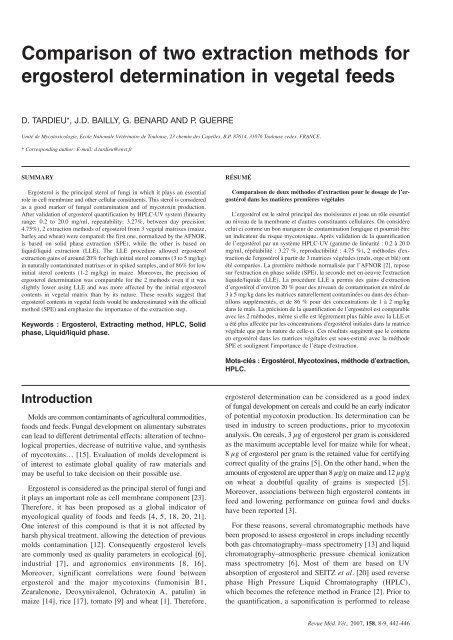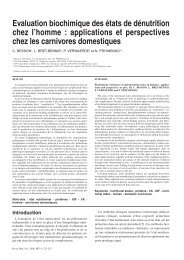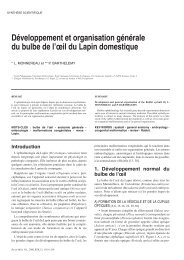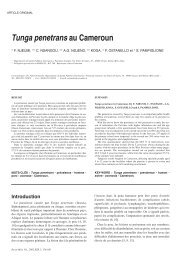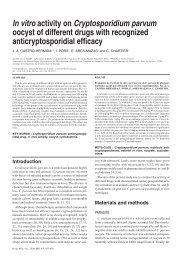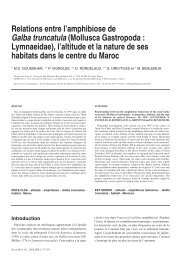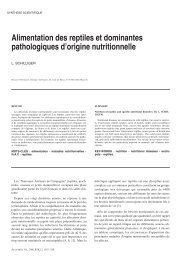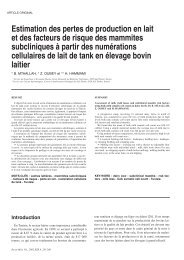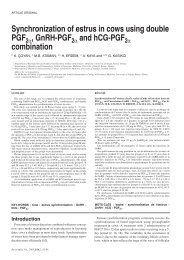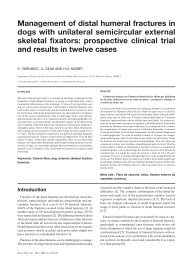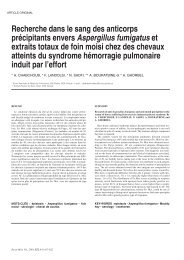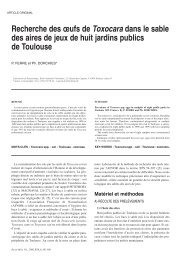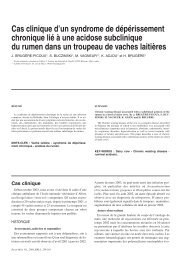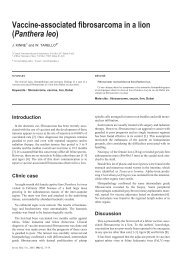Comparison of two extraction methods for ergosterol determination ...
Comparison of two extraction methods for ergosterol determination ...
Comparison of two extraction methods for ergosterol determination ...
You also want an ePaper? Increase the reach of your titles
YUMPU automatically turns print PDFs into web optimized ePapers that Google loves.
<strong>Comparison</strong> <strong>of</strong> <strong>two</strong> <strong>extraction</strong> <strong>methods</strong> <strong>for</strong><br />
<strong>ergosterol</strong> <strong>determination</strong> in vegetal feeds<br />
D. TARDIEU*, J.D. BAILLY, G. BENARD AND P. GUERRE<br />
Unité de Mycotoxicologie, Ecole Nationale Vétérinaire de Toulouse, 23 chemin des Capelles, B.P. 87614, 31076 Toulouse cedex, FRANCE.<br />
* Corresponding author: E-mail: d.tardieu@envt.fr<br />
SUMMARY<br />
Ergosterol is the principal sterol <strong>of</strong> fungi in which it plays an essential<br />
role in cell membrane and other cellular constituents. This sterol is considered<br />
as a good marker <strong>of</strong> fungal contamination and <strong>of</strong> mycotoxin production.<br />
After validation <strong>of</strong> <strong>ergosterol</strong> quantification by HPLC-UV system (linearity<br />
range: 0.2 to 20.0 mg/ml, repeatability: 3.27%, between day precision:<br />
4.75%), 2 <strong>extraction</strong> <strong>methods</strong> <strong>of</strong> <strong>ergosterol</strong> from 3 vegetal matrixes (maize,<br />
barley and wheat) were compared: the first one, normalized by the AFNOR,<br />
is based on solid phase <strong>extraction</strong> (SPE), while the other is based on<br />
liquid/liquid <strong>extraction</strong> (LLE). The LLE procedure allowed <strong>ergosterol</strong><br />
<strong>extraction</strong> gains <strong>of</strong> around 20% <strong>for</strong> high initial sterol contents (3 to 5 mg/kg)<br />
in naturally contaminated matrixes or in spiked samples, and <strong>of</strong> 86% <strong>for</strong> low<br />
initial sterol contents (1-2 mg/kg) in maize. Moreover, the precision <strong>of</strong><br />
<strong>ergosterol</strong> <strong>determination</strong> was comparable <strong>for</strong> the 2 <strong>methods</strong> even if it was<br />
slightly lower using LLE and was more affected by the initial <strong>ergosterol</strong><br />
contents in vegetal matrix than by its nature. These results suggest that<br />
<strong>ergosterol</strong> contents in vegetal feeds would be underestimated with the <strong>of</strong>ficial<br />
method (SPE) and emphasize the importance <strong>of</strong> the <strong>extraction</strong> step.<br />
Keywords : Ergosterol, Extracting method, HPLC, Solid<br />
phase, Liquid/liquid phase.<br />
RÉSUMÉ<br />
Comparaison de deux méthodes d’<strong>extraction</strong> pour le dosage de l’ergostérol<br />
dans les matières premières végétales<br />
L’ergostérol est le stérol principal des moisissures et joue un rôle essentiel<br />
au niveau de la membrane et d'autres constituants cellulaires. On considère<br />
celui ci comme un bon marqueur de contamination fongique et pourrait être<br />
un indicateur du risque mycotoxique. Après validation de la quantification<br />
de l’ergostérol par un système HPLC-UV (gamme de linéarité : 0,2 à 20.0<br />
mg/ml, répétabilité : 3.27 %, reproductibilité : 4.75 %), 2 méthodes d'<strong>extraction</strong><br />
de l'ergostérol à partir de 3 matrices végétales (maïs, orge et blé) ont<br />
été comparées. La première méthode normalisée par l’AFNOR [2], repose<br />
sur l'<strong>extraction</strong> en phase solide (SPE), la seconde met en oeuvre l'<strong>extraction</strong><br />
liquide/liquide (LLE). La procédure LLE a permis des gains d'<strong>extraction</strong><br />
d’ergostérol d’environ 20 % pour des niveaux de contamination en stérol de<br />
3 à 5 mg/kg dans les matrices naturellement contaminées ou dans des échantillons<br />
supplémentés, et de 86 % pour des concentrations de 1 à 2 mg/kg<br />
dans le maïs. La précision de la quantification de l’ergostérol est comparable<br />
avec les 2 méthodes, même si elle est légèrement plus faible avec la LLE et<br />
a été plus affectée par les concentrations d'ergostérol initiales dans la matrice<br />
végétale que par la nature de celle-ci. Ces résultats suggèrent que le contenu<br />
en ergostérol dans les matrices végétales est sous-estimé avec la méthode<br />
SPE et soulignent l'importance de l’étape d'<strong>extraction</strong>.<br />
Mots-clés : Ergostérol, Mycotoxines, méthode d’<strong>extraction</strong>,<br />
HPLC.<br />
Introduction<br />
Molds are common contaminants <strong>of</strong> agricultural commodities,<br />
foods and feeds. Fungal development on alimentary substrates<br />
can lead to different detrimental effects: alteration <strong>of</strong> technological<br />
properties, decrease <strong>of</strong> nutritive value, and synthesis<br />
<strong>of</strong> mycotoxins… [15]. Evaluation <strong>of</strong> molds development is<br />
<strong>of</strong> interest to estimate global quality <strong>of</strong> raw materials and<br />
may be useful to take decision on their possible use.<br />
Ergosterol is considered as the principal sterol <strong>of</strong> fungi and<br />
it plays an important role as cell membrane component [23].<br />
There<strong>for</strong>e, it has been proposed as a global indicator <strong>of</strong><br />
mycological quality <strong>of</strong> foods and feeds [4, 5, 18, 20, 21].<br />
One interest <strong>of</strong> this compound is that it is not affected by<br />
harsh physical treatment, allowing the detection <strong>of</strong> previous<br />
molds contamination [12]. Consequently <strong>ergosterol</strong> levels<br />
are commonly used as quality parameters in ecological [6],<br />
industrial [7], and agronomics environments [8, 16].<br />
Moreover, significant correlations were found between<br />
<strong>ergosterol</strong> and the major mycotoxins (fumonisin B1,<br />
Zearalenone, Deoxynivalenol, Ochratoxin A, patulin) in<br />
maize [14], rice [17], tomato [9] and wheat [1]. There<strong>for</strong>e,<br />
<strong>ergosterol</strong> <strong>determination</strong> can be considered as a good index<br />
<strong>of</strong> fungal development on cereals and could be an early indicator<br />
<strong>of</strong> potential mycotoxin production. Its <strong>determination</strong> can be<br />
used in industry to screen productions, prior to mycotoxin<br />
analysis. On cereals, 3 µg <strong>of</strong> <strong>ergosterol</strong> per gram is considered<br />
as the maximum acceptable level <strong>for</strong> maize while <strong>for</strong> wheat,<br />
8 µg <strong>of</strong> <strong>ergosterol</strong> per gram is the retained value <strong>for</strong> certifying<br />
correct quality <strong>of</strong> the grains [5]. On the other hand, when the<br />
amounts <strong>of</strong> <strong>ergosterol</strong> are upper than 8 µg/g on maize and 12 µg/g<br />
on wheat a doubtful quality <strong>of</strong> grains is suspected [5].<br />
Moreover, associations between high <strong>ergosterol</strong> contents in<br />
feed and lowering per<strong>for</strong>mance on guinea fowl and ducks<br />
have been reported [3].<br />
For these reasons, several chromatographic <strong>methods</strong> have<br />
been proposed to assess <strong>ergosterol</strong> in crops including recently<br />
both gas chromatography–mass spectrometry [13] and liquid<br />
chromatography–atmospheric pressure chemical ionization<br />
mass spectrometry [6]. Most <strong>of</strong> them are based on UV<br />
absorption <strong>of</strong> <strong>ergosterol</strong> and SEITZ et al. [20] used reverse<br />
phase High Pressure Liquid Chromatography (HPLC),<br />
which becomes the reference method in France [2]. Prior to<br />
the quantification, a saponification is per<strong>for</strong>med to release<br />
Revue Méd. Vét., 2007, 158, 8-9, 442-446
ERGOSTEROL DETERMINATION IN VEGETAL FEEDS: COMPARISON OF EXTRACTION METHODS 443<br />
esterified <strong>ergosterol</strong> from cytosolic lipid particles. This<br />
hydrolysis allows total <strong>ergosterol</strong> quantification (free <strong>ergosterol</strong><br />
from fungi walls and cellular/cytoplasmic <strong>ergosterol</strong><br />
stemming from ergosteryl esters). Total <strong>ergosterol</strong> amount is<br />
usually considered as the most sensitive marker <strong>of</strong> fungal<br />
biomass [20]. After this saponification step, an<br />
<strong>extraction</strong>/purification procedure by solid phase <strong>extraction</strong> is<br />
required by some <strong>methods</strong> [2] whereas other authors described<br />
the use <strong>of</strong> a liquid/liquid purification/<strong>extraction</strong> [4]. Some<br />
discrepancies on results obtained by different techniques<br />
show that it is really important to elaborate or modify actual<br />
analytical techniques <strong>for</strong> quantifying <strong>ergosterol</strong> rapidly with<br />
sufficient accuracy.<br />
The aim <strong>of</strong> this study is to compare the yield <strong>of</strong> these <strong>two</strong><br />
<strong>extraction</strong>/purification procedures on maize, wheat and barley<br />
to determine what should be the best screening method <strong>for</strong><br />
crops.<br />
Materials and Methods<br />
CHEMICALS AND REAGENTS<br />
Ergosterol standard (5,7,22-ergostatrien-3β-ol; EC n° 200-<br />
352-7, purity min. 90%) was purchased from Sigma. A stock<br />
solution at 1000 mg/L in dichloromethane/isopropanol<br />
(99.5/0.5) was diluted with the same solvent to obtain standard<br />
solutions ranging from 0.5 to 20.0 mg/L. Stock solution<br />
was stored at -20°C whereas standard dilutions where kept at<br />
4°C <strong>for</strong> one week. All solvents used <strong>for</strong> <strong>extraction</strong>, clean up<br />
and chromatography were <strong>of</strong> HPLC grade and purchased<br />
from ICS (Toulouse, France). SPE Extrelut 20 cartridges<br />
were purchased from Merck (Darmstadt, Germany).<br />
SAMPLE EXTRACTION PROCEDURES<br />
Samples (5 kg) <strong>of</strong> maize, wheat and barley from France,<br />
with no trace <strong>of</strong> mold development macroscopically detectable<br />
were first grinded in meal. Then, meal sub samples <strong>of</strong> 15 g<br />
were used <strong>for</strong> analysis.<br />
Extraction <strong>of</strong> <strong>ergosterol</strong> was per<strong>for</strong>med using the method<br />
<strong>of</strong> SCHWADORF and MULLER [19] with modifications<br />
according to the AFNOR norm NFV 18-112 [2]. Briefly, 15<br />
g <strong>of</strong> meal, 45 mL <strong>of</strong> methanol, 15 mL <strong>of</strong> ethanol, 6 g <strong>of</strong><br />
KOH, and 60 µL <strong>of</strong> pyrogallol (10% in methanol) were<br />
refluxed <strong>for</strong> 30 minutes at 80°C. The mixture was cooled to<br />
20°C and filtered through fluted paper.<br />
Solid Phase Extraction (SPE)<br />
Three mL <strong>of</strong> the saponified mixture were applied on the<br />
Extrelut® column. After 20 minutes, <strong>ergosterol</strong> was eluted<br />
by 15 ml hexane. The eluate was then evaporated in the dark<br />
under a gentle stream <strong>of</strong> nitrogen. The dry residue was dissolved<br />
in 1 mL <strong>of</strong> dichloromethane be<strong>for</strong>e HPLC quantification.<br />
Liquid/Liquid Extraction (LLE)<br />
Fifteen mL <strong>of</strong> the saponified mixture were extracted twice<br />
with 30 mL <strong>of</strong> petroleum ether. This extract was then washed<br />
twice with acidifed water (2 mL H 2 SO 4 95% in 1 L <strong>of</strong> distilled<br />
water, pH 1). The extracted mixture (3 mL) was then evaporated<br />
in the dark under a gentle stream <strong>of</strong> nitrogen. The dry<br />
residue was dissolved in 1 mL <strong>of</strong> dichloromethane be<strong>for</strong>e<br />
HPLC quantification.<br />
HPLC PROCEDURES<br />
Chromatographic system is composed by a M 2200 pump<br />
(Bisch<strong>of</strong>f, Leonberg, Germany) connected to a Lichrospher<br />
Si 100, 5 µm , 250 x 4.6 mm (Bisch<strong>of</strong>f, Leonberg, Germany).<br />
The UV detection was monitored by a Spectra-focus<br />
(Spectra physics, USA). The chromatograms obtained were<br />
monitored by PIC 3 s<strong>of</strong>tware (ICS, Toulouse, France). Both<br />
standard and samples (20 µL) were eluted by dichloromethane/<br />
isopropanol (99.5/0.5). Flow rate was 1.1 mL/min.<br />
Ergosterol peak was detected at λ = 282 nm. Ergosterol was<br />
quantified in samples by peak area measurement and comparison<br />
with peak area obtained <strong>for</strong> standard solutions.<br />
Standard solutions were used to per<strong>for</strong>m a regression study<br />
between the observed area and the injected quantity <strong>of</strong> <strong>ergosterol</strong>.<br />
Five concentrations were injected in triplicate to check the<br />
linear range and estimate the detection limit on standards.<br />
Repeatability was assessed with a same standard solution (5 mg/L)<br />
which has been injected ten folds successively. The same<br />
standard solution (5 mg/L) was used over a long period <strong>of</strong><br />
time to assess the “between run” precision. Recovery was<br />
assessed on maize meal (n = 6) spiked with 5 mg/kg <strong>of</strong> pure<br />
<strong>ergosterol</strong> regarding the same maize without spiking (n = 8).<br />
STATISTICAL ANALYSIS<br />
Results obtained with the <strong>two</strong> extracting <strong>methods</strong> were<br />
compared by comparison <strong>of</strong> means (Student t test).<br />
Differences were considered as significant when the p values<br />
were less than 0.05.<br />
Results and discussion<br />
VALIDATION OF HPLC PROCEDURES<br />
In our experimental conditions, retention time <strong>of</strong> <strong>ergosterol</strong><br />
was about 7 minutes (fig 1A).<br />
Linearity<br />
The detected response (as measured by peak area in µv x s)<br />
was strongly correlated with <strong>ergosterol</strong> concentration <strong>for</strong> all<br />
over the range <strong>of</strong> the tested concentration (from 0.2 to 20.0 mg/L,<br />
r = 0.995 with a slope <strong>of</strong> 250000 and passing by the origin).<br />
The limit <strong>of</strong> detection was estimated at 2 ng <strong>ergosterol</strong> injected<br />
on the column (Table 1). Another statistical complementary<br />
approach was per<strong>for</strong>med to confirm linearity. The variation<br />
coefficient <strong>of</strong> the response factor (response/ concentration)<br />
was calculated <strong>for</strong> each concentration tested (Table 1). Since<br />
the variation coefficient <strong>of</strong> the response factor is less than<br />
10%, we can consider that the response <strong>of</strong> the detector is<br />
linear <strong>for</strong> <strong>ergosterol</strong> concentrations ranging from 0.2 to 20.0 mg/L<br />
[11].<br />
Revue Méd. Vét., 2007, 158, 8-9, 442-446
444 TARDIEU (D) AND COLLABORATORS<br />
Since finding meal or grain without <strong>ergosterol</strong> is impossible,<br />
<strong>ergosterol</strong> content was firstly measured in one batch <strong>of</strong><br />
maize considered as mildly contaminated with molds (n = 8).<br />
This batch was further used <strong>for</strong> recovery <strong>determination</strong><br />
assays by spiking it with pure <strong>ergosterol</strong> at 5 mg/kg (n = 6).<br />
The mean percentage <strong>of</strong> recovery obtained by iteration with<br />
the sigma plot s<strong>of</strong>tware in maize supplemented with 5 mg <strong>of</strong><br />
<strong>ergosterol</strong> /kg was 83 ± 28% with the SPE method and 102<br />
± 9% with the LLE. The value obtained with the SPE was in<br />
agreement with those generally reported (around 90%) [2, 4,<br />
10, 19].<br />
FIGURE 1: A: Chromatogram <strong>of</strong> a 20 mg/L standard solution <strong>of</strong> <strong>ergosterol</strong>.<br />
B: Chromatogram <strong>of</strong> a maize sample extracted with Solid Phase<br />
Extraction (SPE).<br />
C: Chromatogram <strong>of</strong> a maize sample extracted with Liquid/Liquid<br />
Extraction (LLE).<br />
Repeatability and “between day” precision<br />
One standard solution (0.5 mg/L) was injected ten times<br />
successively in the chromatographic system. The percentage<br />
<strong>of</strong> variation obtained on the peak area recorded was 3.27%<br />
(Table 1). The same standard was injected each day during<br />
one week period (n = 6). The percentage <strong>of</strong> variation obtained<br />
on the peak surface was 4.75 % (Table 1). During this study,<br />
we noted that the diluted standard solution was not stable<br />
with time when stored at 4°C in the dark. Indeed, a decrease<br />
<strong>of</strong> 20% was recorded on peak area after <strong>two</strong> weeks and this<br />
diminution reached 50% after three weeks (data not shown).<br />
COMPARISON OF THE TWO EXTRACTION PROCEDURES<br />
Recovery <strong>of</strong> <strong>ergosterol</strong><br />
No interfering peak was seen on chromatograms obtained<br />
after SPE or LLE <strong>of</strong> the same saponification extract (fig. 1B,<br />
1C). Higher peaks were obtained with LLE in front <strong>of</strong> the<br />
chromatograms signalling a lower specificity concerning<br />
apolar substances compared to SPE. They did not interfere<br />
with interpretation <strong>of</strong> chromatograms because they are in<br />
earlier retention time zone (be<strong>for</strong>e 7 minutes).<br />
The <strong>two</strong> <strong>extraction</strong> <strong>methods</strong> were per<strong>for</strong>med using the<br />
same saponification mixture prepared from the same spiked<br />
sample. For each <strong>determination</strong>, <strong>ergosterol</strong> content was<br />
always higher with the LLE procedure than with the SPE<br />
one. Albeit the standard deviations greatly varied, they<br />
remained comparable with those already described <strong>for</strong> repeatability,<br />
variation coefficients (VC) ranging from 5 to 21% in<br />
the SPE method [2]. Moreover, since data were obtained<br />
during several days, they also were in<strong>for</strong>mative on between<br />
days reproducibility. The only available results concerning<br />
reproductibility <strong>of</strong> the SPE method were those <strong>of</strong> an interlaboratory<br />
study. They revealed important differences with<br />
deviations in results ranging from 10 to 55% [2].<br />
Determination <strong>of</strong> <strong>ergosterol</strong> in samples<br />
Together maize, wheat and barley were tested <strong>for</strong> <strong>ergosterol</strong><br />
content. For each raw material, six samples <strong>of</strong> the same batch<br />
were analysed. After the saponification <strong>of</strong> the meal, <strong>ergosterol</strong><br />
<strong>of</strong> each sample was extracted using either SPE as described<br />
in the <strong>of</strong>ficial method or <strong>for</strong> the LLE procedure. The retention<br />
time <strong>of</strong> <strong>ergosterol</strong> was around 7 minutes whatever the <strong>extraction</strong><br />
method and chromatograms in this zone were quite similar<br />
(fig 1B. 1C).<br />
Table 2 presents the comparison <strong>of</strong> the <strong>two</strong> extracting<br />
<strong>methods</strong> on the different matrixes. Whatever the studied<br />
matrixes (maize, barley or wheat), the average <strong>ergosterol</strong><br />
contents as well as almost all the individual sample values<br />
obtained after LLE (n = 6) were always significantly higher<br />
than those obtained after SPE in <strong>of</strong>ficial method (p
ERGOSTEROL DETERMINATION IN VEGETAL FEEDS: COMPARISON OF EXTRACTION METHODS 445<br />
which the <strong>ergosterol</strong> content was the lowest (1.23 and 2.32<br />
mg/kg <strong>for</strong> SPE and LLE respectively). As the repeatability<br />
and the reproductibility <strong>of</strong> the HPLC quantification step<br />
were respectively 3.27% and 4.75%, the great variations in<br />
<strong>ergosterol</strong> recovery were probably related to the saponification<br />
and/or the <strong>extraction</strong> steps. Because high variation coefficients<br />
were observed with the <strong>two</strong> <strong>extraction</strong> procedures, the<br />
decrease <strong>of</strong> precision <strong>for</strong> <strong>ergosterol</strong> <strong>determination</strong> would<br />
probably due to the low <strong>ergosterol</strong> content in this matrix<br />
rather than the matrix nature, i.e. maize. Indeed, the same VC<br />
(20%) <strong>for</strong> the same contamination level (around 1.5 mg/kg)<br />
was obtained with the <strong>of</strong>ficial method (SPE) <strong>for</strong> different<br />
matrixes [2]. Intermediate coefficients <strong>of</strong> variations (8%<br />
with SPE and 10% with LLE) were recorded from wheat in<br />
which the highest <strong>ergosterol</strong> content was found (4.26 and<br />
5.11 mg/kg <strong>for</strong> SPE and LLE respectively). These results<br />
were in agreement with those already recorded from wheat<br />
with the standardized method (6.2% repetability and 9.7%<br />
reproductibility) <strong>for</strong> an <strong>ergosterol</strong> contamination level <strong>of</strong> 9<br />
mg/kg and were comparable to those obtained from barley<br />
<strong>for</strong> the same contamination level [2]. Consequently, the<br />
moderate decline <strong>of</strong> precision was linked to the high <strong>ergosterol</strong><br />
content and probably not to a matrix effect. As far as the barley<br />
matrix was concerned, low coefficients <strong>of</strong> variation (5% and<br />
9% <strong>for</strong> SPE and LLE respectively) were observed <strong>for</strong> moderate<br />
<strong>ergosterol</strong> amount (3.38 and 4.12 mg/kg <strong>for</strong> SPE and LLE<br />
respectively). Again, this relative high precision degree was<br />
associated with the sterol concentration instead <strong>of</strong> the matrix<br />
nature. Indeed, the <strong>of</strong>ficial method exhibits the same coefficient<br />
<strong>of</strong> variation <strong>for</strong> the same contamination level (around 3-3.5 mg/kg)<br />
<strong>for</strong> different matrixes (maize: 5%, wheat 6.2%) but no data<br />
were available <strong>for</strong> barley [2].<br />
Taken together, the precision degree <strong>of</strong> <strong>ergosterol</strong> <strong>determination</strong><br />
in the vegetal feeds is essentially dependant on the initial<br />
<strong>ergosterol</strong> amounts and matrixes effects seem to be minor.<br />
Conclusion<br />
The Liquid-Liquid extracting/purification method (LLE)<br />
seems particularly adapted <strong>for</strong> studying <strong>ergosterol</strong> in various<br />
matrixes. Indeed, the <strong>ergosterol</strong> quantification by HPLC analysis<br />
exhibits gains <strong>of</strong> <strong>extraction</strong>s reaching 20 % on wheat<br />
Matrix<br />
Maize (n = 6)<br />
Mean<br />
Median<br />
SD*<br />
VC* (%)<br />
Gain LLE/SPE (%)<br />
P<br />
Barley (n = 6)<br />
Mean<br />
Median<br />
SD*<br />
VC* (%)<br />
Gain LLE/SPE (%)<br />
P<br />
Wheat (n = 6)<br />
Mean<br />
Median<br />
SD*<br />
VC* (%)<br />
Gain LLE/SPE (%)<br />
P<br />
Ergosterol content (mg/kg) according to the 2 <strong>extraction</strong> <strong>methods</strong><br />
SPE<br />
LLE<br />
1.23<br />
2.32<br />
1.15<br />
2.33<br />
0.25<br />
0.72<br />
20<br />
31<br />
31<br />
86.1 ± 30.3<br />
3.38<br />
3.36<br />
0.18<br />
5<br />
4.26<br />
4.27<br />
0.36<br />
8<br />
< 0.01<br />
< 0.01<br />
< 0.05<br />
4.12<br />
4.00<br />
0.38<br />
9<br />
21.9 ± 9.0<br />
5.11<br />
5.05<br />
0.53<br />
10<br />
21.0 ± 0.2<br />
*VC: Variation coefficient; SD: Standard deviation<br />
TABLE 2: Determination <strong>of</strong> total <strong>ergosterol</strong> by HPLC-UV on a batch (n = 6) <strong>of</strong> maize, barley and wheat.<br />
After saponification step, a liquid/liquid <strong>extraction</strong> (LLE) was compared to a solid phase <strong>extraction</strong><br />
(SPE) on the same extract. Results were expressed in mg/kg <strong>of</strong> meal.<br />
Revue Méd. Vét., 2007, 158, 8-9, 442-446
446 TARDIEU (D) AND COLLABORATORS<br />
and barley compared to the SPE procedure. A gain <strong>of</strong> 86 %<br />
was even found on maize, but on this matrix, the low level <strong>of</strong><br />
<strong>ergosterol</strong> in tested samples (1 mg/kg) may contribute to<br />
these great differences between the 2 <strong>extraction</strong> <strong>methods</strong>. It<br />
seems that <strong>for</strong> such low concentrations the whole saponification/<br />
<strong>extraction</strong>/<strong>determination</strong> may not be very reproducible whatever<br />
the method considered (variation coefficients ranging from<br />
20 to 30%). The deficit <strong>of</strong> <strong>ergosterol</strong> extracted by the SPE<br />
procedure could be explained by irreversible adsorption <strong>of</strong><br />
<strong>ergosterol</strong> on the solid phase as already described <strong>for</strong> other<br />
compounds as organophosphorus on SPE columns [22].<br />
Since the precision (variability) <strong>of</strong> each method is quite<br />
similar and seems to be more dependent on <strong>ergosterol</strong> levels<br />
(inversely proportional) than on matrixes, this study demonstrates<br />
that Liquid-liquid <strong>extraction</strong> <strong>of</strong> <strong>ergosterol</strong> is a simple<br />
and cheap method, particularly adapted <strong>for</strong> <strong>ergosterol</strong> screening<br />
from many vegetal matrixes.<br />
Finally this study tends to demonstrate that <strong>ergosterol</strong><br />
levels are probably underestimated with the <strong>of</strong>ficial method<br />
that could partially explain some discrepancies that are<br />
sometimes reported between <strong>ergosterol</strong> quantification and<br />
molds numeration and/or mycotoxin analysis <strong>of</strong> raw materials<br />
[5, 12].<br />
References<br />
1. - ABRAMSON D., HULASARE R., YORK R.K., WHITE N.D.G.,<br />
JAYAS D.S.: Mycotoxins, <strong>ergosterol</strong>, and odors volatiles in durum<br />
wheat during granary storage at 16% and 20% moisture content. J.<br />
Stored Products Res., 2005, 41, 67-76.<br />
2. - AFNOR, Norme NF V 18-112, Aliments des animaux- Détermination<br />
de la teneur en ergostérol. Tour Europe cedex 792049 Paris la defense,<br />
1991.<br />
3. - ARTURO-SCHAAN M., CLEMENT F., GUERRE P.: Impact de la<br />
qualité fongique et mycotoxicologique sur la production des pintades<br />
et des palmipèdes gras. 6° Journées de la Recherche Avicole, St<br />
MALO, 30-31 mars 2005.<br />
4. - BAILLY J.D., LE BARS P., PIETRI A., BERNARD G., LE BARS J.:<br />
Evaluation <strong>of</strong> a fuorodensitometric method <strong>for</strong> analysis <strong>of</strong> <strong>ergosterol</strong><br />
as a fungal marker in compound feeds. J. Food Prot., 1999, 62, 686-<br />
690.<br />
5. - CAHAGNIER B.: Moisissures des aliments peu hydratés, 225 pages,<br />
Lavoisier, Paris, 1998.<br />
6. - HEADLEY J.V., PERU K.M., VERMA B., ROBARTS R.D.: Mass<br />
spectrometric <strong>determination</strong> <strong>of</strong> <strong>ergosterol</strong> in a prairie natural wetland.<br />
J. Chromatogr. A, 2002, 958, 149-156.<br />
7. - HIPPELEIN M., RUGAMER M.: Ergosterol as an indicator <strong>of</strong> mould<br />
growth on building materials. Int. J. Hyg. Environ. Health, 2004, 207,<br />
379-385.<br />
8. - KADAKAL C., ARTIK N.: A new quality parameter in tomato and<br />
tomato products: <strong>ergosterol</strong>. Crit. Rev. Food Sci. Nutr., 2004, 44, 349-<br />
351.<br />
9. - KADAKAL C., NAS S., EKINCI R.: Ergosterol as a new quality<br />
parameter together with patulin in raw apple juice produced from<br />
decayed apples. Food Chem., 2005, 90, 95-100.<br />
10. - LARSEN T., AXELSEN J., RAVN H.W.: Simplified and rapid<br />
method <strong>for</strong> <strong>extraction</strong> <strong>of</strong> <strong>ergosterol</strong> from natural samples and detection<br />
with quantitative and semi-quantitative <strong>methods</strong> using thin<br />
layer chromatography. J. Chromatogr. A, 2004, 1026, 301-304.<br />
11. - LECOMPTE D.: Validation d’une méthode de dosage par chromatographie<br />
liquide. S.T.P. PHARMA, 1986, 2, 843-849.<br />
12. - MAUPETIT P.: Qualité sanitaire des aliments pour animaux: teneur<br />
en ergostérol, traceur d’un développement fongique. In J. LE BARS<br />
(éd): Contamination par les moisissures des aliments pour animaux,<br />
AFTAA adeprina, Paris, 1994, p 41-51.<br />
13. - NIELSEN K.F., MADSEN J.O.: Determination <strong>of</strong> <strong>ergosterol</strong> on<br />
mouldy building materials using isotope dilution and gas chromatographytandem<br />
mass spectrometry. J. Chromatogr. A, 2000, 898, 227-234.<br />
14. - PIETRI A., BERTUZZI T., PALLARONI L., PIVA P.: Occurrence<br />
<strong>of</strong> mycotoxins and <strong>ergosterol</strong> in maize harvested over 5 years in<br />
Northern Italy. Food Addit. Contam., 2004, 21, 479-487.<br />
15. - PITT J. I., HOCKING A.D.: Fungi and food spoilage. Academic<br />
press, New York, 1985.<br />
16. - SASHIDHAR RAO B., SUDERSHAN RAO V., RAMAKRISHNA<br />
Y., BHAT R.V.: Rapid and specific method <strong>for</strong> screening <strong>ergosterol</strong><br />
as index <strong>of</strong> fungal contamination in cereal grains. Food chem.,<br />
1989, 31, 51-56.<br />
17. - SAXENA J., MUNIMBAZI C., BULLERMAN L.B.: Relationship<br />
<strong>of</strong> mould count, <strong>ergosterol</strong> and ochratoxin A production. Int. J. Food<br />
Microbiol., 2001, 71, 29-34.<br />
18. - SCHUNÜRER J.: <strong>Comparison</strong> <strong>of</strong> <strong>methods</strong> <strong>for</strong> estimating the biomass<br />
<strong>of</strong> three food-borne fungi with different growth patterns. Appl.<br />
Environ. Microbiol., 1993, 59, 552-555.<br />
19. - SCHWADORF K., MÜLLER H.M.: Determination <strong>of</strong> <strong>ergosterol</strong> in<br />
cereals, mixed feed components, and mixed feeds by liquid chromatography.<br />
J. Assoc. Anal. Chem., 1989, 72, 457-462.<br />
20. - SEITZ L.M., MOHR H.E., BURROUGHS R., SALIER D.B.:<br />
Ergosterol as an indicator <strong>of</strong> fungal invasion in grains. Cereal<br />
Chem., 1977, 54, 1207-1217.<br />
21. - SEITZ L.M., SAUER D.B., BURROUGHS R., MOHR H.E.,<br />
HUBARD J.D.: Ergosterol as a measure <strong>of</strong> fungi growth.<br />
Phytopathology, 1979, 69, 1202-1203.<br />
22. - TOLOSA I., READMAN J.W., MEE L.M.: <strong>Comparison</strong> <strong>of</strong> the per<strong>for</strong>mance<br />
<strong>of</strong> solid phase <strong>extraction</strong> techniques in recovering organophosphorous<br />
and organochlorine compounds from water. J.<br />
Chromatogr. A, 1996, 725, 93-106.<br />
23. - WEETE J.D.: Lipid biochemistry <strong>of</strong> fungi and other organism.<br />
Plenium Press, New York, 1980.<br />
Revue Méd. Vét., 2007, 158, 8-9, 442-446


